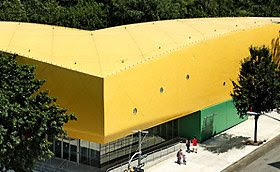 The Brooklyn Children’s Museum reopened Saturday after a year-long closure for an expansion and redesign. According to the New York Times:
The Brooklyn Children’s Museum reopened Saturday after a year-long closure for an expansion and redesign. According to the New York Times:
The museum doubled the size of its city-owned building — with $48 million in city money and $32 million raised by the museum — to 102,000 square feet. As Robin Pogrebin reported in The Times in February, the project struggled through financial hardships. The museum itself lacked a strong physical identity, because most of its space has been underground since a 1977 design by Hardy Holzman Pfeiffer Associates created two lower levels. The greatly enlarged museum now hopes to improve its annual visitor total to 400,000 by 2010, from about 250,000 before the museum closed last September for the final stage of the renovation.
A pioneer in education, the Brooklyn Children’s Museum was the first museum created expressly for children when it was founded in 1899. Its success has sparked the creation of 300 children’s museums around the world. It is the only children’s museum in New York City, and one of few in the country, to be accredited by the American Association of Museums. The Museum encourages children to develop an understanding of and respect for themselves, others and the world around them by exploring cultures, the arts, science, and the environment.
The just-completed expansion features eco-friendly design in hopes of attaining LEED certification – it’s said to be the first “green” museum in New York City. In keeping with the Museum’s commitment to preserve and protect the world’s natural resources, it uses environmentally advanced, sustainable, renewable and/or recyclable materials and systems in the building’s design and construction.
Brooklyn Children’s Museum is one of the few children’s museums in the world with a permanent collection, including nearly 30,000 cultural objects and natural-history specimens. The cultural collection contains both ancient and present-day objects, including musical instruments, sculpture, masks, body adornments, and dolls, as well as everyday household and personal items. The natural-history collection contains rocks, minerals, and fossils, as well as mounted birds, mammals, insects, and skeletons (highlights include the complete skeleton of an Asian elephant, dinosaur footprints, and a whale rib).
For years, much of the collection has been inaccessible to the public simply because of space limitations. Now, an expanded collection study area allows the Museum to display more of the collection and to offer more hands-on activities—so children learn by touching as well as by looking.